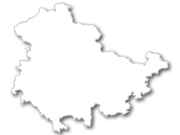Located in the heart of Germany, the Thuringian Forest is an idyllic region of lush green landscapes, charming villages and remarkable history.
Stretching some 120 kilometres from north-west to south-east, it is one of Central Europe's most attractive destinations for nature lovers, hikers and history buffs alike. The area is particularly famous for the Rennsteig, a historic ridgeway trail that runs through the magnificent forest landscape.
Majestic beech and spruce trees dominate the forest, while rare and protected fauna such as the Eurasian lynx and various bird species find sanctuary within its boundaries.
The forest is also home to several natural attractions, including the famous Dragon Gorge, a narrow gorge with impressive rock formations.
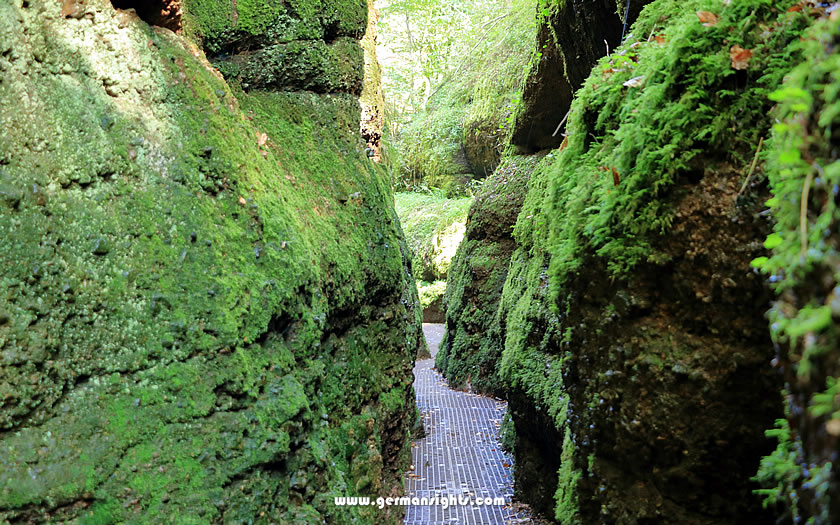
Part of the Dragon Gorge near Eisenach
As well as its natural wonders, the Thuringian Forest has a rich cultural heritage.
The region has played a significant role in German history, being a major centre for art, literature and religious reformation.
By exploring the many picturesque villages dotted across the landscape, travellers can discover the lives and times of notable figures such as the poet Friedrich Schiller and the theologian Martin Luther.
The Thuringian Forest is also dotted with medieval castles and monasteries, a visual reminder of the region's turbulent past.
The low mountains of the Thuringian Forest stretch across the federal states of Thuringia, Hesse, and Bavaria.
The region covers an area of approximately 2,400 square kilometres. The landscape consists mainly of rolling hills, steep valleys and dense mixed forests. The highest peak, the Großer Beerberg, is 982 metres above sea level.
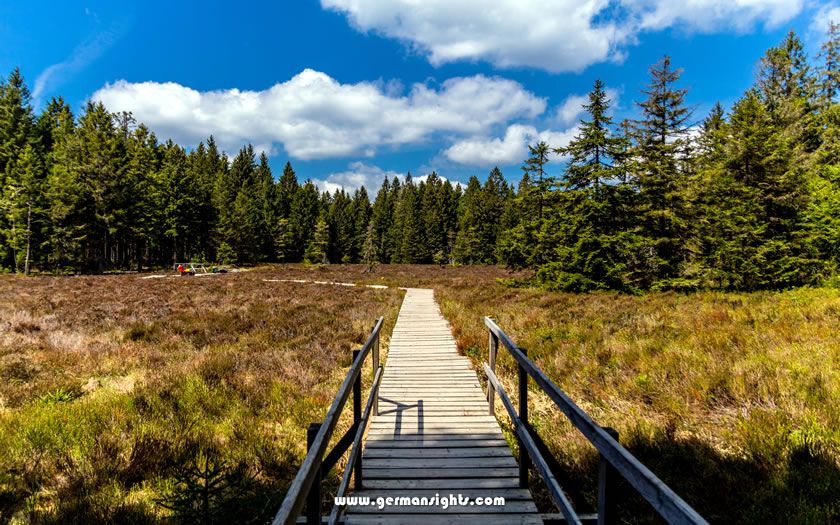
Hiking trail in the Thuringian Forest
The region also boasts several ski resorts, offering winter sports enthusiasts a variety of downhill and cross-country skiing options.
The Thuringian Forest Nature Park (Naturpark Thüringer Wald) is a protected area that covers a significant portion of the Thuringian Forest.
The nature park spans approximately 2,082 square kilometres, extending from Hörschel in the northwest to Sonneberg and Neustadt bei Coburg in the southeast.
Martin Luther, the influential theologian and central figure of the Protestant Reformation, wasn't born in the forest region itself but some key events in his life took place in nearby cities and towns.
Johann Sebastian Bach, a notable composer and musician of the Baroque period, was born in Eisenach, located in the Thuringian Forest region. Bach spent the first ten years of his life in Thuringia, with the region's culture and traditions significantly influencing his musical development.
This is reflected in his numerous compositions, which are considered some of the finest works of classical music. Several cities in Thuringia, including Arnstadt, Mühlhausen, and Weimar, were places where Bach lived and worked during various stages of his career.
Johann Wolfgang von Goethe, the famous German writer, poet, and philosopher, has notable connections to the Thuringian Forest region. While his main residence was in Weimar (close to the eastern border of the Thuringian Forest), he frequently visited and explored various locations within the forest during his lifetime.
The Thuringian Forest Nature Park covers a vast area of greenery, making it a popular destination for those who enjoy exploring the great outdoors. Visitors will find a multitude of attractions, such as the Wartburg Castle, numerous hiking routes, and a diverse array of flora and fauna.
The Rennsteig is the most well-known route for hiking and has become synonymous with the Thuringian Forest Nature Park. The trail stretches a total of approximately 170 kilometres and is the longest and most popular ridge walk in the region. Along the way, it passes near many historical and natural sites, including the famous Wartburg Castle near Eisenach.
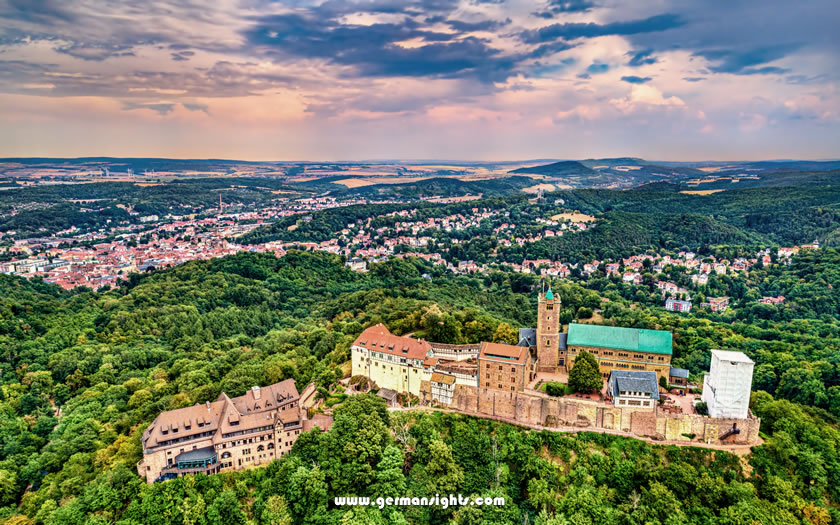
Wartburg castle above Eisenach in Thuringia
Besides the Rennsteig, there are several other hiking trails in the Thuringian Forest Nature Park, allowing visitors to tailor their walks to their desired difficulty level and points of interest.
The Thuringian Forest Nature Park is a veritable sanctuary for a wide variety of plants and wildlife. The dense forests are predominantly made up of:
One of the unique aspects of this park is the presence of a UNESCO Biosphere Reserve, which serves to protect and conserve the rich biodiversity found within the park's boundaries.
Visitors can expect to come across numerous species of ferns, which thrive under the dense tree canopy. Additionally, the nature park is home to a variety of animal species such as deer, wild boars, and several bird species, all contributing to the diverse ecosystem of the Thuringian Forest Nature Park.
The Thuringian Forest offers a variety of winter activities for visitors to enjoy. One of the most popular destinations is Oberhof, a town known for its excellent skiing and snowboarding facilities.
Oberhof provides exceptional alpine skiing and snowboarding opportunities for both beginners and experienced visitors. The town boasts several well-maintained slopes and modern ski lifts.
For those who prefer cross country skiing, the Thuringian Forest has an extensive network of trails. Oberhof's well-groomed trails cater to all skill levels, from novice to advanced skiers.
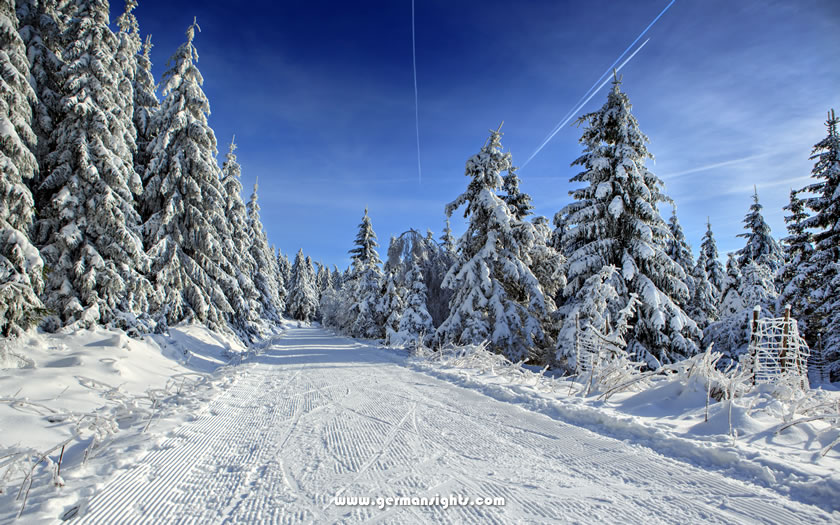
Cross-country ski trail near Masserberg
The Thuringian Forest offers a wealth of walking opportunities for outdoor enthusiasts. One of the most famous walks in the region is the Rennsteig, a 170km trail that runs from Eisenach to Blankenstein.
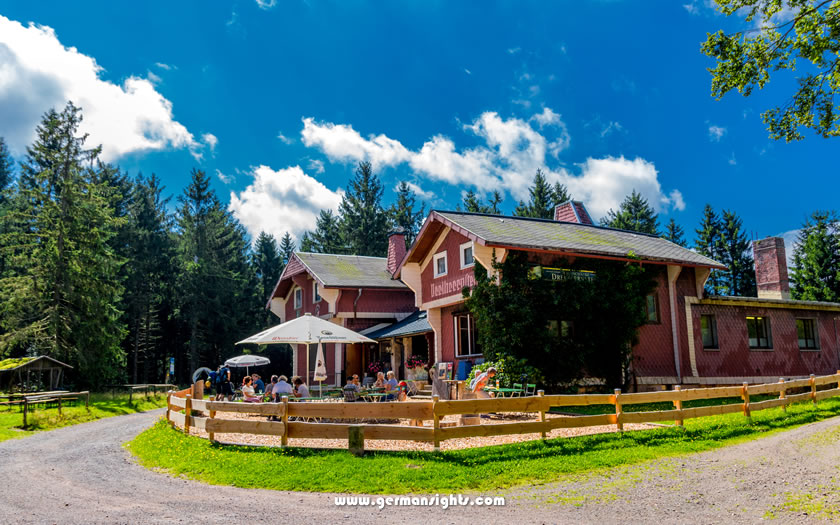
Taking a break along the Rennsteig
This well-maintained path traverses the mountainous region and offers fantastic views of the surrounding countryside. Many walkers choose to climb the Inselsberg, a prominent peak in the Thuringian Forest that rises to 916 metres above sea level.
Among the many other trails in the Thuringian Forest are the following:
Cyclists can also enjoy the beauty of the Thuringian Forest on the extensive network of bike trails. Bikers can expect a mix of gentle inclines, challenging climbs and leisurely descents as they navigate the varied landscape. Some popular routes include:
There are a number of larger towns with good access to the activities in the Thuringian Forest, such as Schmalkalden, Eisenach and Suhl. Those who prefer a quieter destination as a base might like to try these villages:
The town is known for winter sports such as bobsledding, biathlon, and cross-country skiing. The Rennsteiggarten Oberhof is a beautiful garden featuring mountain plants from all over the world and is well worth a visit in summer.
This village has many well-marked trails for summer hiking and winter cross-country skiing. It also hosts several health facilities which specialise in breathing problems because of the clean air.
A small town surrounded by nature, ideal for walking and skiing. It is part of one of Germany's most famous walking routes - the Rennsteig.
Bad Tabarz is located on the edge of the Thüringer Wald. It offers attractions such as Kurpark Tabarz with a fabulous rose garden or a family day out at INSELBERG Funpark. It is also near the Großer Inselberg, a popular viewpoint.
This little village to the north of Oberhof offers numerous trekking paths through thick forests during summer and easy access to ski areas during winter seasons; perfect for outdoor enthusiasts who prefer quieter locations.
The Franconian Forest, known as the "Frankenwald" in German, is a beautiful range of low mountains situated in Northern Bavaria. It covers an area of approximately 2,000 square kilometres and is part of the larger Central Uplands region.
The Franconian Forest is characterized by its heavy coniferous forests and rolling hills, with the highest peak being Döbraberg at 795 metres above sea level.
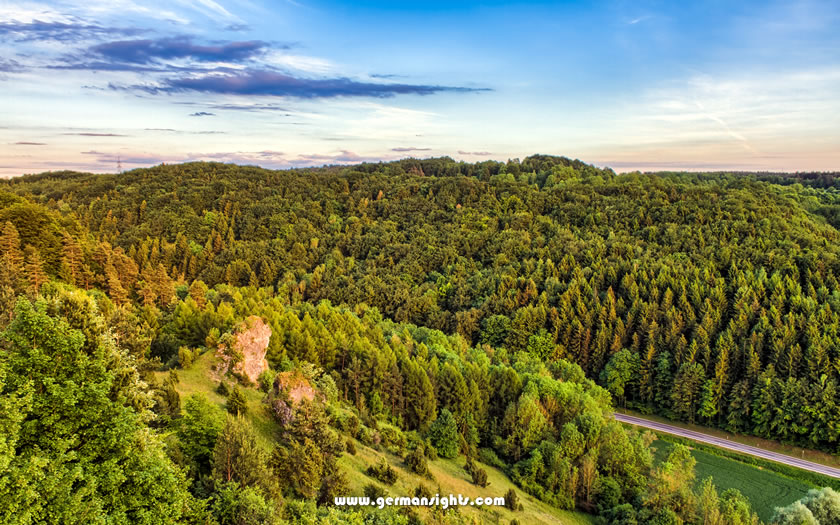
The Franconian forest south of the Thuringian forest
There are several well-marked trails throughout the forest that cater to different levels of difficulty and showcase the diverse flora and fauna native to the area. The Rennsteig trail is one of the most famous long-distance hiking paths in Germany that passes through the Franconian Forest.
The region is also rich in cultural heritage with picturesque towns like Kronach, Kulmbach, Hof, and Münchberg offering a glimpse into traditional German life. Visitors can explore historic castles like Rosenberg Fortress or Plassenburg Castle to learn about the region’s history.
The Thuringian Slate Mountains, or "Thüringer Schiefergebirge" in German, are a low mountain range located primarily in Thuringia, but extending into parts of Bavaria and Saxony. The mountain range spans an area of approximately 1,700 square kilometres and is part of the larger Central German Uplands.
The highest point in the Thuringian Slate Mountains is Großer Beerberg, which reaches an elevation of 983 meters above sea level. The landscape is characterized by its dense forests composed mainly of coniferous trees, deep valleys, and jagged slate rock formations.
The region’s unique geology has led to the development of a long-standing slate mining industry. In fact, Thuringian slate has been used for centuries as a roofing material due to its durability and distinctive appearance.
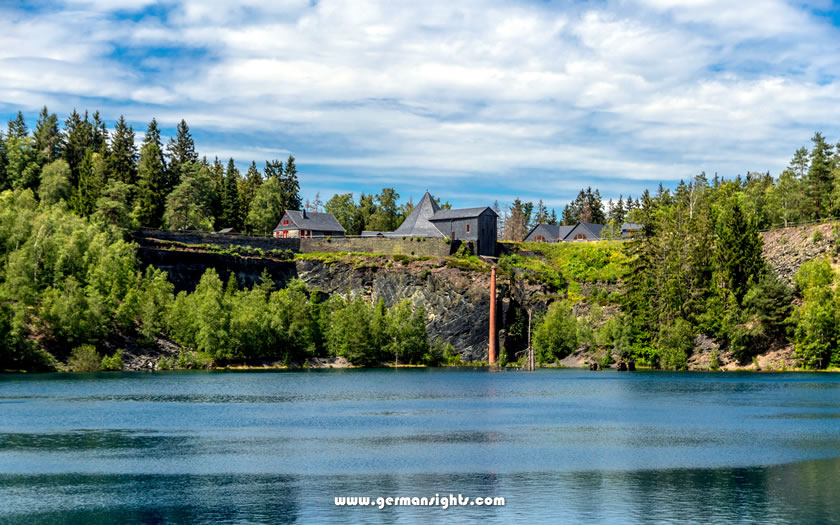
The Thuringian Slate Park
Outdoor enthusiasts will find plenty to do in the Thuringian Slate Mountains. With an extensive network of hiking trails crisscrossing the region, it provides ample opportunities for exploring the scenic beauty on foot. Popular trails include Rennsteig—a renowned long-distance path that traverses both the Franconian Forest and Thuringian Forest and a Höhenwanderweg which runs along the ridges.
In addition to hiking, visitors can enjoy other activities such as cycling or cross-country skiing during winter months. The region also boasts several charming towns like Saalfeld, Sonneberg, and Neuhaus am Rennweg which offer traditional architecture alongside museums that delve into local history.
Official Thüringer Wald Website: www.thueringer-wald.com (German only)
